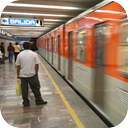(short preview of full seamless looping track)
Mexico City Metro
This product is not available in the selected currency.
In Stock
Backordered
Out of Stock
Description
Deep beneath this mega city slither a huge series of tunnels that tell a tale of infinite variety. Passengers from every possible urban perch find their way down into the earth, escaping the topside turmoil for a little while as they sit in silence, waiting to be dropped off at the edge of some distant section of the city. You creep along the corridors, watching and waiting for your train to arrive while wondering what awaits you at the other end. The Mexico City Metro is the second largest metro system in North America after the New York City Subway, and in 2008 the system served 1.467 billion passengers, placing it as the eighth highest ridership in the world. The first Metro line had 16 stations, and opened to the public in 1969. The system has expanded since then in a series of fits and starts. As of 2010, the system comprises eleven lines and 451 kilometres (280 mi) of passenger track. Ten of the lines are rubber-tyred metro; instead of traditional steel wheels, they have rubber tires, which are quieter and cope better with Mexico City's unstable soils. It has 163 stations, 24 of which serve two or more lines (correspondencias or transfer stations). It has 106 underground stations (the deepest of which are 35 metres below street level); 53 surface stations and 16 elevated stations. By the second half of the twentieth century, Mexico City had serious public transport problems, with congested main roads and highways, especially in the downtown zone, where 40 percent of the daily trips in the city were concentrated. In this area, 65 of the 91 lines of bus and electric transport circulated. With four thousand units in addition to 150,000 personal automobiles peak hours, the traffic speed was less than walking pace. The principal promoter of the construction of Mexico City Metro was engineer Bernardo Quintana, who was in charge of the construction company Ingenieros Civiles y Asociados.
Opps
Sorry, it looks like some products are not available in selected quantity.



